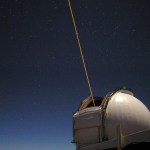adaptive optics
"But certainly the laser proved to be what I realized it was going to be. At that moment in my life I was too ignorant in business law to be able to do it right, and if I did it over again probably the same damn thing would happen." -Gordon Gould, inventor of the laser
You're used to the iconic image of an observatory's dome surrounded by a dark sky. From within, a telescope peers up at the heavens. And with a huge amount of light-gathering power that dwarfs a fully dilated human eye, we can use this tremendous tool to peek into the dark depths of the Universe.
Image credit: Fort Lewis…
What's the application? Producing artificial "stars" to serve as a reference for telescopes using adaptive optics to correct for atmospheric turbulence. This allows ground-based telescopes to produce images that are as good as those from the Hubble Space Telescope.
What problem(s) is it the solution to? "How can I make this giant telescope produce even more impressive pictures?"
How does it work?The basic problem with ground-based telescopes, as anyone who has ever looked at the stars or listened to nursery rhymes can tell you, is that stars "twinkle." They appear to fluctuate in brightness…
